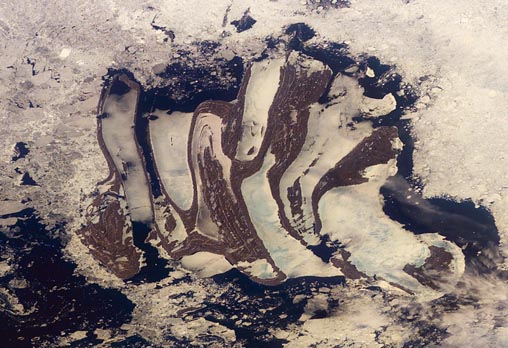Belcher Islands

- STS111-E-5715
- 16 June 2002
 Viewed from above, the Belcher Islands (Sanikiluaq) are perhaps one of
the Earth's strangest looking collection of islands. These ribbon-like islands are located at the southeastern corner of
Hudson Bay, situated northeast from the entrance into James Bay and 105 km west from the Quebec coast of the Canadian mainland.
They form part of the territory of Nunavut.
Viewed from above, the Belcher Islands (Sanikiluaq) are perhaps one of
the Earth's strangest looking collection of islands. These ribbon-like islands are located at the southeastern corner of
Hudson Bay, situated northeast from the entrance into James Bay and 105 km west from the Quebec coast of the Canadian mainland.
They form part of the territory of Nunavut.
The Belcher Islands are the largest island group to be found amongst the several thousand islands and islets that are located on the western side of Hudson Bay. In total there are some 1,500 islands, islets and rocks that comprise the Belcher Islands, with a total land area of 2,870 km². They can be divided into three main groups (listed here with the largest islands in parenthesis): the Belcher Islands proper (Flaherty Island, Innetalling Island, Joy Island, Kugong Island (321 km²), Mavor Island, Ney Island, Tukarak Island (349 km²) and Walton Island); the North Belcher Islands on the northwest (Johnson Island, Laddie Island, Lusikee Islands, Radar Island and Split Island); and the the Baker's Dozen Islands on the northeast (Bun Island, Cake Island, Loaf Island, and Twin Cairns Island). The convoluted Flaherty Island, at 1,525 km² in area, is the largest island of the entire group.
Geologically, the sinuous central islands are formed by the partial submergence of a highly folded series of ancient rocks. The islands are mostly low-lying and of low relief, with the highest terrain generally occurring in the east. Although low, some areas have steep coastal slopes or rise from the sea in cliffs of up to 70 m in height.
Several other major groups of small islands are located in the vicinity (30-40 km radius) of the Belcher Islands; these include the Salikuit Islands (to the west), the King George Islands (to the northwest), and the Sleeper Islands (to the north-northeast) — see panoramic image
image: earth sciences and image analysis laboratory, nasa johnson space center.






